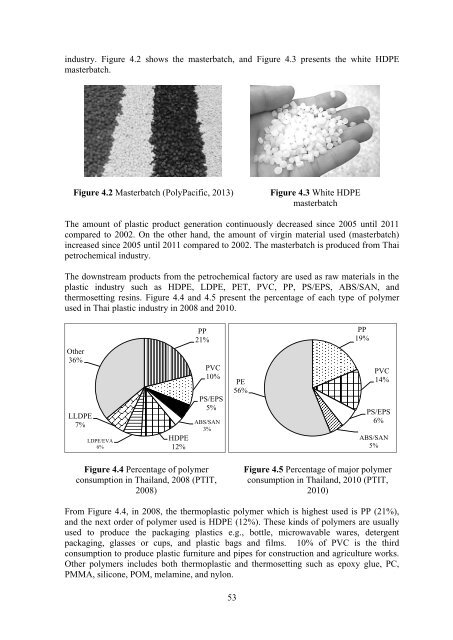Evaluation of Plastic Waste Management in Thailand Using Material ...
Evaluation of Plastic Waste Management in Thailand Using Material ...
Evaluation of Plastic Waste Management in Thailand Using Material ...
Create successful ePaper yourself
Turn your PDF publications into a flip-book with our unique Google optimized e-Paper software.
<strong>in</strong>dustry. Figure 4.2 shows the masterbatch, and Figure 4.3 presents the white HDPE<br />
masterbatch.<br />
Figure 4.2 Masterbatch (PolyPacific, 2013) Figure 4.3 White HDPE<br />
masterbatch<br />
The amount <strong>of</strong> plastic product generation cont<strong>in</strong>uously decreased s<strong>in</strong>ce 2005 until 2011<br />
compared to 2002. On the other hand, the amount <strong>of</strong> virg<strong>in</strong> material used (masterbatch)<br />
<strong>in</strong>creased s<strong>in</strong>ce 2005 until 2011 compared to 2002. The masterbatch is produced from Thai<br />
petrochemical <strong>in</strong>dustry.<br />
The downstream products from the petrochemical factory are used as raw materials <strong>in</strong> the<br />
plastic <strong>in</strong>dustry such as HDPE, LDPE, PET, PVC, PP, PS/EPS, ABS/SAN, and<br />
thermosett<strong>in</strong>g res<strong>in</strong>s. Figure 4.4 and 4.5 present the percentage <strong>of</strong> each type <strong>of</strong> polymer<br />
used <strong>in</strong> Thai plastic <strong>in</strong>dustry <strong>in</strong> 2008 and 2010.<br />
Other<br />
36%<br />
LLDPE<br />
7%<br />
LDPE/EVA<br />
6%<br />
HDPE<br />
12%<br />
PP<br />
21%<br />
PVC<br />
10%<br />
PS/EPS<br />
5%<br />
ABS/SAN<br />
3%<br />
Figure 4.4 Percentage <strong>of</strong> polymer<br />
consumption <strong>in</strong> <strong>Thailand</strong>, 2008 (PTIT,<br />
2008)<br />
53<br />
PE<br />
56%<br />
PP<br />
19%<br />
PVC<br />
14%<br />
PS/EPS<br />
6%<br />
ABS/SAN<br />
5%<br />
Figure 4.5 Percentage <strong>of</strong> major polymer<br />
consumption <strong>in</strong> <strong>Thailand</strong>, 2010 (PTIT,<br />
2010)<br />
From Figure 4.4, <strong>in</strong> 2008, the thermoplastic polymer which is highest used is PP (21%),<br />
and the next order <strong>of</strong> polymer used is HDPE (12%). These k<strong>in</strong>ds <strong>of</strong> polymers are usually<br />
used to produce the packag<strong>in</strong>g plastics e.g., bottle, microwavable wares, detergent<br />
packag<strong>in</strong>g, glasses or cups, and plastic bags and films. 10% <strong>of</strong> PVC is the third<br />
consumption to produce plastic furniture and pipes for construction and agriculture works.<br />
Other polymers <strong>in</strong>cludes both thermoplastic and thermosett<strong>in</strong>g such as epoxy glue, PC,<br />
PMMA, silicone, POM, melam<strong>in</strong>e, and nylon.

















